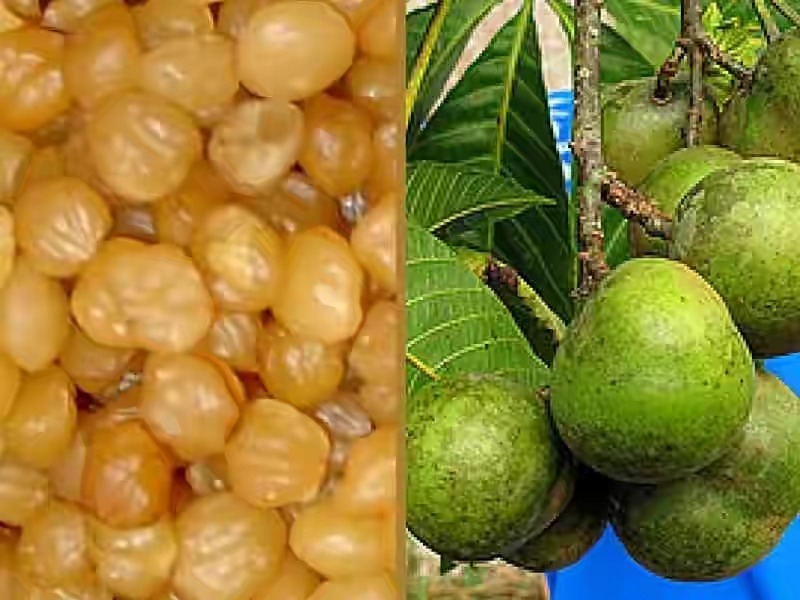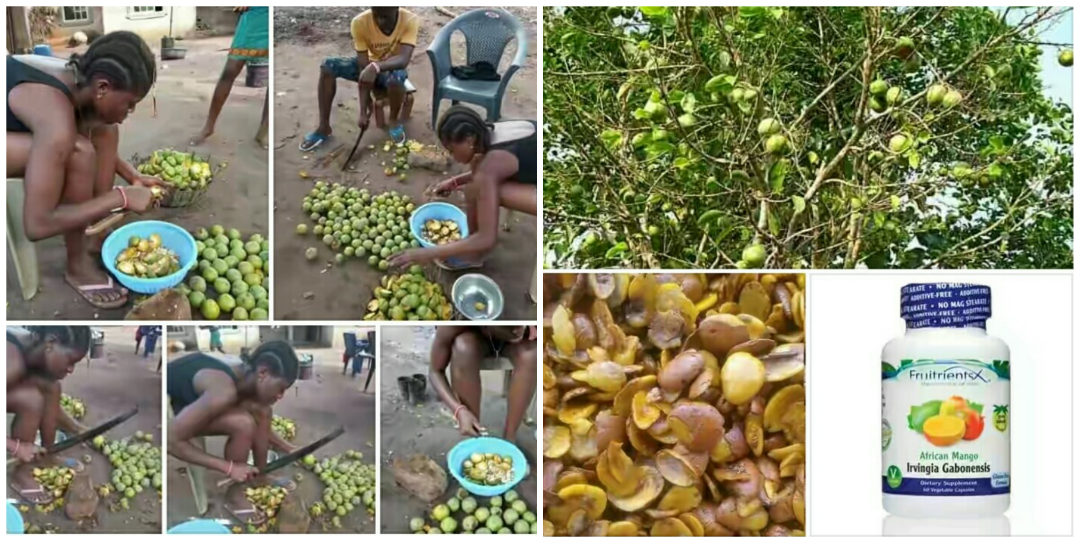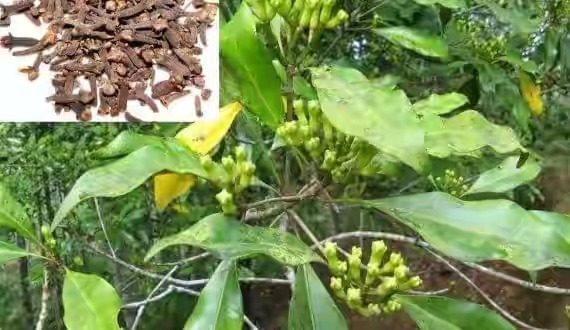Ricinodendron heudelotii; synonyms: Ricinodendron africanum, Barrettia umbrosa, Jatropha heudelotii (Botanical/scientific name) or Akpi, Groundnut tree, African nut tree, African oil-nut-tree, African wood, African wood-oil nut tree, Corkwood tree, Manketti nut, Zambezi almond (English) or Wawan-kurmi (Hausa) or Òkwè, Okengbo (Igbo) or Erin-mado (Yoruba), Njangsa (Cameroon), Okhuen (Nigeria): A multi-purpose African tree with some superstitious applications.
DESCRIPTION AND OCCURRENCE:
Ricinodendron heudelotii is a fast-growing tree, reaching up to 50 m in height and 2.7 m in girth; bole straight with short buttress; bark grey, smooth at first, becoming scaly with ageing; slash dark red, densely mottled with scattered pits and orange stone-cell granules.
Leaves alternate, digitately 3-5 foliate; leaflets sessile or subsessile, glandular, denticulate, often white-felted on the underside at 1st with stellate pubescent hairs, becoming glabrous; obovate to obovate-elliptic; apex long-acuminate; base cuneate; stipules large, foliaceus, persistent, deeply toothed. Inflorescence yellow tomentose; male panicles up to 41 cm long; female panicles shorter and stouter; male flowers with 5 sepals, a 5-lobed corolla tube and 10 stamens; female flowers with stellate tomentose ovary and 2 styles, slender and bipartite.
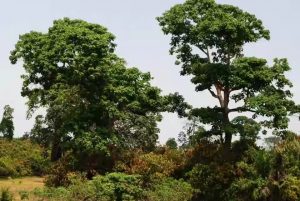
Fruit indehiscent, 2-3 lobed, 2 celled, with a thick, hard shell and a smell of overripe apples; contains 2-3 red-brown-black seeds, rounded, flat, over 1 cm across. Two varieties are recognized: R. heudelotii var. heudelotii in Ghana, and R. heudelotii var. africanum in Nigeria and westwards. The generic name is based on the Greek words for tick and tree because the seeds were thought to resemble ticks.
Akpi tree regenerates readily from the stump, and it comes up freely on old farms. In open light spaces it will bear fruit in the seventh to tenth year, and its rapidity of growth is proverbial. It grows spontaneously from seed and is often preserved in the neighbourhood of forest villages. Hunters recognise the tree as attractive to wild animals which eat the fallen fruits.
R. heudelotii is a tree of the fringing, deciduous and secondary forests common throughout the semi-dry, wooded-savannah zone of the region. From lower Senegal to west Cameroon and Fernando Po, to Democratic Republic of Congo, Angola and Tanzania, where it is found scattered in gaps at forest edges and in secondary scrub and thickets. The tree is native to: Angola, Benin, Cameroon, Congo, Cote d’Ivoire, Democratic Republic of Congo, Gabon, Ghana, Guinea-Bissau, Kenya, Liberia, Nigeria, Senegal, Sierra Leone, Tanzania, Togo, Uganda and Zambia.
USES/IMPORTANCE/HEALTH BENEFITS OF AKPI/OKHUEN/NJANGSA
The seeds of Ricinodendron heudelotii are widely used in cooking in West and Central Africa. Edible oil is extracted from the seeds and a paste made by crushing dried kernels is sometimes used as a thickening agent for soups and stews. The seeds are edible, but not everywhere valued as food.
The kernels are eaten boiled in water or in sauce like ground-nuts in Ivory Coast or mixed with fish, meat and other vegetables.
In Gabon, they are roasted and made into a paste. They are recorded as being eaten by the Efik people of Nigeria and in Liberia.
The dried seeds of Ricinodendron heudelotii contain on average per 100 g: water 6 g, energy 530 kcal, protein 21 g, fat 43 g, carbohydrate 23 g, Ca 611 mg, P 926 mg, Fe 0.4 mg, thiamin 10 μg, riboflavin and traces of niacin. As can be seen, the seeds are very rich in both vitamins and minerals as well as protein.
Some sources give a fat content of up to 60%. The fat is pale yellow and liquid but somewhat viscous at ambient temperatures. Its fatty acid composition is: palmitic acid 6-10%, stearic acid 6-7%, oleic acid 7-9%, linoleic acid 28-36%, α-eleostearic acid 30-51%. The fat also contains small amounts of β-eleostearic acid, catalpic acid, gadoleic acid and lignoceric acid. A paste from the dried and pounded kernels is also stored for making porridge in times of food shortage.
The protein-rich leaves are eaten as a cooked vegetable with dried fish and are used as forage for goats and sheep. Because of the high energy and protein content, African nut tree undoubtedly can be used for the prevention and management of protein-energy malnutrition, which prevalence is high in developing countries, including Nigeria.
Alpha-eleostearic acid is a rare fatty acid, which has been demonstrated to possess scavenging (removing) properties against dangerous free radicals. Apart from the African nut tree, this fatty acid can be found in abundance only in bitter gourd oil.
Many scientists working in the field of oncology have shown that alpha-eleostearic acid has a strong suppressive effect on tumour growth through induction (stimulation) of apoptosis (programmed death of cancer cells) as well as controlling the multiplication of cancer cells.
Many parts of the tree are used in medicine. Bark of the root and stem is used in decoctions or lotions to treat constipation, cough, dysentery, rheumatism, rickets in children, oedema, elephantiasis, fungal infection, blennorrhoea, painful menstruation, and to prevent miscarriage, relieve pain in pregnant women, cure infertility in women, give strength to premature babies, and to mature abscesses, furuncles and buboes.
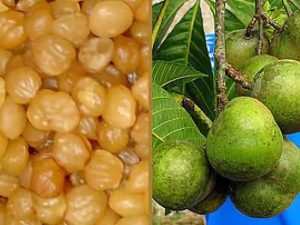
Root-bark is used in Nigeria when ground up and mixed with pepper and salt for constipation. Temne people of Sierra Leone tie to the body bark which has been beaten and warmed for elephantiasis. In Liberia, a bark-liquor is taken by pregnant women to relieve pains and to prevent miscarriage.
It is also taken by women “to kill a worm which is in the bowels and which prevents them from breeding”. In Ivory Coast, a root-bark-decoction of akpi taken by mouth is considered a powerful anti-dysenteric, and stem-bark is taken by enema to prevent abortion.
Stem-bark-decoction of Okhuen is also used to wash and cicatrise sores. In Gabon, a bark-decoction is taken for blennorrhoea and in Congo, it is taken by draught for cough, blennorrhoea, painful menstruation and as a poison-antidote; in lotions and baths to strengthen rachitic children and premature babies, and to relieve rheumatism and oedemas; and pulped the bark (also the leaves) is applied to fungal infections, to maturate abscesses, furuncles and buboes, and expressed sap is instilled to the eye for filaria and ophthalmias. The sap is instilled into the eye against filaria and ophthalmia and leaf decoctions are used as febrifuge.
Leaves are also used to treat dysentery, female sterility, oedema and stomach pain. Roots of Okhuen are used as aphrodisiac in Côte d’Ivoire. Fruits and latex are used in West Africa to cure gonorrhoea and diarrhoea.
A leaf-decoction of Akpi is taken by draught and in baths in Ivory Coast as a febrifuge and leaves are used to treat dysentery, female sterility, oedemas. and stomach-pains. In Nigeria, the root when ground up and mixed with pepper and salt is used for constipation.
The wood, called ‘erimado’ or ‘essessang’ in trade, is very light, soft and perishable, but is occasionally used in carving and for making household utensils, furniture, boxes and crates. In Uganda the Semliki and Unyoro people use it for making doors for their huts, while in Southern Nigeria and the Democratic Republic of Congo well-sounding drums are carved from it.
It is a potential substitute for balsa wood for making floats and lifebelts. The wood is also suitable for boat building, sporting goods, toys and novelties, hardboard, particle board, plywood, wood-wool and wood-pulp. The ash of the wood is used as vegetable salt in cooking, indigo dyeing and soap making.
The seeds are used in rattles and as counters in games. In Bas Congo, the tree is planted to attract edible caterpillars, which are collected from it. The leaves are used as wrapping material and for mulching.
In the Democratic Republic of Congo, Ricinodendron heudelotii is planted as amenity tree, as live fence and for erosion control. The wood is indifferent as fuel since it burns with great rapidity, but the ash is used in Guinea for the preparation of a vegetable-salt in soap-making and in indigo dyeing and in Sierra Leone Mendes people use it for soap-making. The wood is perhaps suitable for paper-pulp.
Akpi seeds are used in rattles in bundu dances in Sierra Leone. They are also used in Nigeria in a game played by the Igbo called Òkwè and another in Cameroun called Songo, both forms of Mancala. It will be noted that the Igbo word applies equally to the game as to the tree. Njangsa is the name of Ricinodendron heudelotii in Cameroon.
Superstitious applications of the tree are practised on the Liberian/Ivory Coast border region where hunters cover their faces with bark ash. This, they hold, enables them to kill all elephants they see.
FUTURE PROSPECTS
Continuing intensification of agriculture in humid tropical Africa will increasingly rely on domesticated, fast-growing, multi-purpose tree species that fit well in agroforestry systems. If selections can be made that meet farmers’ requirements and if appropriate packages of management practices can be developed, Ricinodendron heudelotii is likely to become a more important component of such systems and contribute to the regional demand for edible and industrial oil.
MAJOR REFERENCES:
1) Nature’s gifts: improving trees and shrubs around the world. Ricinodendron heudelotii in Nigeria. Agroforestry Today 8(2): 18;
2) Chemical composition of Ricinodendron heudelotii: an indigenous fruit tree in southern Cameroon. African Crop Science Journal 8(2): 195-201;
3) Choosing the right trees: setting priorities for multipurpose tree improvement. ISNAR Research Report 8.
These are the thoughts and intellectual property of:
Sa’eed Halilu Bawa
Senior Lecturer (Associate Professor) at University of the West Indies, St. Augustine Campus, Trinidad.
Studied Food and Nutrition Sciences, Dietetics at Kaduna Polytechnic, Nigeria; Warsaw University of Life Sciences, Poland.

















